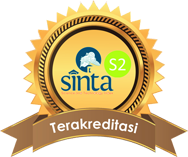Design of Science Process Skill-Based Intertextual Learning on Reaction Kinetics Concept
DOI:
https://doi.org/10.15575/jtk.v7i2.20883Keywords:
catalyst, intertextual learning strategy, kinetics reaction, predict-observe-explain, science process skillsAbstract
References
Adadan, E. (2013). Using multiple representations to promote grade 11 students’ scientific understanding of the particle theory of matter. Research in Science Education, 43(3), 1079-1105. https://doi.org/10.1007/s11165-012-9299-9
Algiranto, Sarwanto, & Marzuki, A. (2019) .The development of studen worksheet based on predict, observe, explain (POE) to improve students' science process skill in SMA Muhammadiyah Imogiri. IOP Conf. Series: Journal of Physics: Conf. Series, 1153 (012148), 1-7. 10.1088/1742-6596/1153/1/012148
Brady, J. E., Jespersen, N. D., & Hyslop, A. (2012). Chemistry: the molecular nature of matter. USA: John Willey & Sons, Inc.
Brown, T. E, Lemay, H. E., Bursten, B. E., Murphy, C. J., & Woodward, P. M. (2012) Chemistry the central science twelfth edition. USA: Prentice Hall.
Carin, A.A. (1997). Teaching modern science. New Jersey: PracticeHall.
Chang, R. (2010). Chemistry 10th edition. New York: McGraw-Hill.
Chittleborough, G. (2004). The roll of teaching models and chemical representations in developing students’ mental models of chemical phenomena. Tesis, Curtain University, Perth.
Dimyati, & Mudjiono. (2002). Belajar dan pembelajaran. Jakarta: PT. Rineka Cipta.
Firman, H. (2013). Evaluasi pembelajaran kimia. Bandung: Pendidikan Kimia Universitas Pendidikan Indonesia.
Gultepe, N. (2016). High school science teachers’ views on science process skills. International Journal of Environmental & Science Education, 11(5), 779-800. Retrieved from https://eric.ed.gov/?id=EJ1114270
Handayanti, Y., Setiabudi, A., & Nahadi. (2015). Analisis profil model mental siswa SMA pada materi laju reaksi. Jurnal Penelitian dan Pembelajaran IPA, 1 (1), 107-122. http://dx.doi.org/10.30870/jppi.v1i1.329
Kibirige, I., Osodo, J., & Tlala, K.M. (2014). The effect of predict-observe-explain strategy on learners’ misconceptions about dissolved salts. Mediterranean Journal of Social Sciences, 5(4), 300-310. http://dx.doi.org/10.5901/mjss.2014.v5n4p300
Kirik, O.T., & Boz, Y. (2012) Cooperative learning instruction for conceptual change in the concepts of chemical kinetics. Chemistry Education Research and Practice, 13, 221–236. https://doi.org/10.1039/C1RP90072B
Lukum, A., & Paramata, Y. (2015). Students’ satisfaction toward the series of the chemical laboratory. Internasional Journal of Evaluation and Research in Education (IJERE), 4(1), 22- 29. Retrieved from https://eric.ed.gov/?id=EJ1091700
Murezhawati, E., Hairida, & Melati, H. A. (2017) Peningkatan keterampilan proses sains siswa SMA dengan model pembelajaran predict- observe- explain materi hidrolisis garam. Jurnal Pendidikan dan Pembelajaran, 6(8), 1-11. http://dx.doi.org/10.26418/jppk.v6i8.21116
Petruci, R. H. (2011). General chemistry: principles and modern applications. Toronto: Pearson.
Rahayu, I. (2022). Studi konsepsi, troublesome knowledge dan threshold concept pada konsep faktor-faktor yang mempengaruhi laju reaksi berdasarkan tes diagnostik model mental interview about event (TDM-IAE). (Tesis Magister, Universitas Pendidikan Indonesia). Retrieved from http://repository.upi.edu/79476/
Silberberg, M. S. (2013). Principles of general chemistry 3rd edition. USA: McGraw-Hill.
Sukmawati, W. (2019). Analisis level makroskopis, mikroskopis dan simbolik mahasiswa dalam memahami elektrokimia. Jurnal Inovasi Pendidikan IPA, 5(2), 195-204. http://dx.doi.org/10.21831/jipi.v5i2.27517
Syamsiana, F., Suyatno, S., & Taufikurahmah, T. (2018) The effectiveness of using POE (predict-observe-explain) strategy on students’ learning result of reaction rate chapter in SMA. Jurnal Penelitian Pendidikan Sains, 7(2), 1507- 1512. https://doi.org/10.26740/jpps.v7n2.p1507-1512
Tasker, R., & Dalton, R. (2006) Research into practice: visualization of the molecular world using animations. Chemistry Education Research and Practice, 7 (2), 141-159. Retrieved from https://www.rsc.org/images/Tasker-Dalton%20paper%20final_tcm18-52113.pdf
Titari, I., & Nasrudin, H. (2017). Keterlaksanaan strategi konflik kognitif untuk mereduksi miskonsepsi siswa kelas XI SMAN 1 Kertosono pada materi laju reaksi. UNESA J. Chem. Educ., 6 (2), 144–149. Retrieved from https://jurnalmahasiswa.unesa.ac.id/index.php/journal-of-chemical-education/article/view/20187
Treagust, D., Chittleborough, G., & Mamiala, T. (2003) The role of submicroscopic and symbolic representations in chemical explanations. International Journal of Science Education, 25 (11), 1353-1368. https://doi.org/10.1080/0950069032000070306
Uce, M., & Ceyhan,I. (2019). Misconception in chemistry education and practices to eliminate them: literature analysis. Journal of Education and Training Studies, (3)7, 202-208. http://dx.doi.org/10.11114/jets.v7i3.3990
Warsono, & Hariyanto. (2017). Pembelajaran aktif : Teori dan Assesment. Bandung: PT. Remaja Rosdakarya.
White, R., & Gunstone, R. (2014). Probing understanding. New York: Routledge.
Whitten, K. W., Davis, R. E., Peck, M. L., & Stanley, G. G. (2014). Chemistry tenth edition. Brooks/ Cole: Cengange Learning.
Wiyarsi, A., Sutrisno, H., & Rohaeti, E. (2018). The effect of multiple representation approach on students’ creative thinking skills: a case of ‘rate of reaction’ topic. IOP Conf. Series: Journal of Physics: Conf. Series, 1097 (012054), 1-9. 10.1088/1742-6596/1097/1/012054
Wu, H. K. (2003). Linking the microscopic view of chemistry to real life experiences: intertextuality in a high-school science classroom. Science Education, 87(6), 868-891. https://doi.org/10.1002/sce.10090
Yuliana, I. F., Dasna, I. W., & Marfuah, S. (2015). Pengaruh inkuiri terbimbing dengan intertekstual terhadap hasil belajar materi kesetimbangan kimia dan literasi kimia ditinjau dari kemampuan awal. Seminar Nasional Pendidikan Sains UKSW, Universitas Negeri Malang, Malang. Retrieved from https://repository.uksw.edu/bitstream/123456789/7738/2/PROS_Ika%20FY%2C%20I%20Wayan%20D%2C%20Siti%20M_Pengaruh%20Model%20Inkuiri_fulltext.pdf
Yuliani, N., & Dwiningsih, K. (2014). Melatihkan keterampilan proses siswa pada materi faktor-faktor yang mempengaruhi laju reaksi melalui model pembelajaran inkuiri. Unesa Journal of Chemical Education, 3(1), 35-40. Retrieved from https://jurnalmahasiswa.unesa.ac.id/index.php/journal-of-chemical-education/article/view/6950
Zeidan, A.H. & Jayosi, M.R. (2015). Science process skills and attitude toward science among Palestinian secondary school students. Sciedu Press 5(1), 13-24. Retrieved from https://files.eric.ed.gov/fulltext/EJ1158460.pdf
Zulfahmi, Wiji, & Mulyani, S. (2021). Development of intertextual based learning strategy using visualization model to improve spatial ability on molecular geometry concept. Chimica Didactica Acta, 9 (1), 8-16. https://doi.org/10.24815/jcd.v9i1.20078
Downloads
Published
How to Cite
Issue
Section
Citation Check
License
Authors who publish with this journal agree to the following terms:
- Authors retain copyright and grant the journal right of first publication with the work simultaneously licensed under a Creative Commons Attribution-ShareAlike that allows others to share the work with an acknowledgement of the work's authorship and initial publication in this journal.
- Authors are able to enter into separate, additional contractual arrangements for the non-exclusive distribution of the journal's published version of the work (e.g., post it to an institutional repository or publish it in a book), with an acknowledgement of its initial publication in this journal.
- Authors are permitted and encouraged to post their work online (e.g., in institutional repositories or on their website) prior to and during the submission process, as it can lead to productive exchanges, as well as earlier and greater citation of published work (See The Effect of Open Access).








